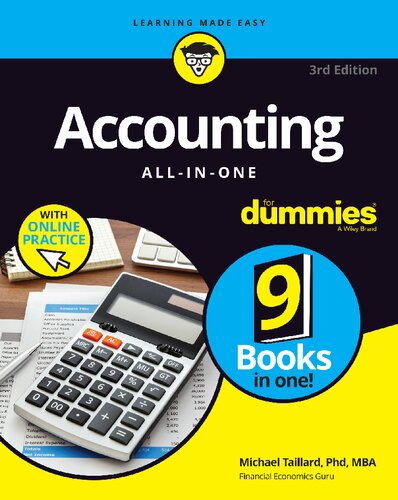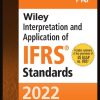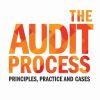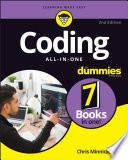(Ebook PDF) Accounting All in One For Dummies 3rd Edition by Michael Taillard, Joseph Kraynak, Kenneth Boyd 1119897688 9781119897682 full chapters
$50.00 Original price was: $50.00.$25.00Current price is: $25.00.
Accounting All-in-One For Dummies 3rd Edition by Michael Taillard, Joseph Kraynak, Kenneth W. Boyd – Ebook PDF Instant Download/DeliveryISBN: 1119897688, 9781119897682
Full dowload Accounting All-in-One For Dummies 3rd Edition after payment.

Product details:
ISBN-10 : 1119897688
ISBN-13 : 9781119897682
Author: Michael Taillard, Joseph Kraynak, Kenneth W. Boyd
A complete and easy-to-follow resource covering every critical step of the accounting process Learning to love the language of business is easier than you think! In the newly revised Third Edition of Accounting All-In-One For Dummies with Online Practice, finance expert Michael Taillard walks you through every step of the accounting process, from setting up your accounting system to auditing and detecting financial irregularities. You’ll enjoy a unified compilation of mini-books and online practice and video resources that bring together everything you need to know about accounting into one convenient book and web portal. You’ll learn to record accounting transactions, adjust and close entries, prepare income statements and balance sheets, and more.
Accounting All-in-One For Dummies 3rd Table of contents:
Chapter 1: Accounting for the Basics
Knowing What Bookkeeping and Accounting Are All About
Wrapping Your Brain around the Accounting Cycle
Working the Fundamental Accounting Equation
Chapter 2: Charting Your Accounts
Navigating the Chart of Accounts
Setting Up Your Chart of Accounts
Giving Credit (Or Is It Debit?)
Understanding Double-Entry Accounting
Chapter 3: Using Journal Entries and Ledgers
Keeping a Journal
Bringing It All Together in the Ledger
Putting Accounting Software to Work for You
Chapter 4: Choosing an Accounting Method
Choosing Your Method
Sorting through Standards for Other Types of Accounting
Chapter 5: Setting the Standards
Exploring the Origins of Accounting Standards
Recognizing the Role of the American Institute of Certified Public Accountants
Checking Out the U.S. Securities and Exchange Commission
Getting to Know the Financial Accounting Standards Board
Grasping Accounting Standards Around the Globe
Book 2: Recording Transactions
Chapter 1: Keeping the Books
Analyzing the Effect of Business Transactions
Managing Your Bookkeeping and Accounting System
Wrapping Up with End-of-Period Procedures
Chapter 2: Tracking Purchases
Keeping Track of Inventory
Buying Supplies
Handling Billing and Payables
Chapter 3: Tallying Your Sales
Collecting on Cash Sales
Selling on Credit
Proving Out the Cash Register
Tracking Sales Discounts
Recording Returns and Allowances
Monitoring Accounts Receivable
Accepting Your Losses
Chapter 4: Processing Employee Payroll and Benefits
Staffing Your Business
Collecting Employee Taxes
Determining Net Pay
Surveying Your Benefits Options
Preparing Payroll and Posting It in the Books
Depositing Employee Taxes
Chapter 5: Taxing Payrolls
Paying Employer Taxes on Social Security and Medicare
Completing Unemployment Reports and Paying Unemployment Taxes
Carrying Workers’ Compensation Insurance
Maintaining Employee Records
Book 3: Adjusting and Closing Entries
Chapter 1: Depreciating Your Assets
Appreciating Depreciation
Comparing Depreciation Options
Tackling Taxes and Depreciation
Chapter 2: Interesting Rates
Deciphering Types of Interest
Handling Interest Income
Delving into Loans and Interest Expenses
Chapter 3: Proving Out Cash
Making Sure That Ending Cash Is Right
Closing the Cash Journals
Using a Temporary Posting Journal
Chapter 4: Reconciling Accounts and Closing Journal Entries
Reconciling Bank Accounts
Prepping to Close: Checking for Accuracy and Tallying Things Up
Posting to the General Ledger
Checking Out Computerized Journal Records
Chapter 5: Checking Your Accuracy
Working with a Trial Balance
Testing Your Balance by Using Computerized Accounting Systems
Developing a Financial Statement Worksheet
Replacing Worksheets with Computerized Reports
Chapter 6: Adjusting the Books
Adjusting All the Right Areas
Testing an Adjusted Trial Balance
Book 4: Preparing Income Statements and Balance Sheets
Chapter 1: Stating Your Income
Understanding the Nature of Profit
Choosing the Income-Statement Format
Deciding What to Disclose in the Income Statement
Examining How Sales and Expenses Change Assets and Liabilities
Considering the Diverse Financial Effects of Making a Profit
Reporting Extraordinary Gains and Losses
Correcting Common Misconceptions about Profit
Chapter 2: Balancing Your Sheets
Homing in on Historic Cost
Discovering What Makes an Asset Current
Exploring the Asset Section of the Balance Sheet
Chapter 3: Digging for Debt in the Balance Sheet
Seeing How Businesses Account for Liabilities
Keeping Current Liabilities under Control
Planning for Long-Term Obligations
Accounting for Bond Issuances
Chapter 4: Explaining Equity
Understanding How Owner Equity Varies among Business Entities
Distinguishing between Two Types of Capital Stock
Defining Paid-In Capital
Recording Retained Earnings
Spotting Reductions to Stockholders’ Equity
Exploring Stock Splits
Computing Earnings per Share
Chapter 5: Interpreting Income Statements and Balance Sheets
Rejoining the Income Statement and Balance Sheet
Introducing Operating Ratios
Adding Fixed Assets, Depreciation, and Owners’ Equity
Completing the Balance Sheet with Debt
Book 5: Reporting Your Statements
Chapter 1: Valuating Finances
Clarifying the Values of Assets in Balance Sheets
Introducing Business Valuation
Comparing Business Valuation Methods
Chapter 2: Watching Cash Flow and Equity
Understanding the Difference between Cash and Profit
Flowing Through Cash Transactions
Navigating the Three Flows
Preparing the Statement of Cash Flows
Interpreting the Statement of Cash Flows
Stating Changes in Stockholders’ Equity
Chapter 3: Analyzing Financial Statements
Judging Solvency and Liquidity
Driving the Balance Sheet
Measuring Profitability
Exploring Activity Measures
Comparing Horizontal and Vertical Analysis
Using Common Size Financial Statements
Chapter 4: Explaining Disclosures
Questioning Self-Governance
Identifying Corporate Characteristics
Reviewing Common Explanatory Notes
Putting the Onus on the Preparer
Chapter 5: Sharing Public Reports
Differentiating between Private and Public Companies
Finding Purpose in Reports
Reading the Annual Report to Shareholders
Walking through Form 10-K
Book 6: Planning and Budgeting for Your Business
Chapter 1: Looking at the Legals
Surveying Structures
Going It Alone: Sole Proprietorships
Choosing the Right Legal Structure for Income Tax
Chapter 2: Incorporating Your Business
Securing Capital: Starting with Owners
Recognizing Legal Roots
Incorporating a Business
Chapter 3: Drawing Up a Business Plan
Outlining the Basic Business Plan
Developing a Business Plan
Incorporating Third-Party Information into Your Plan
Chapter 4: Budgeting for a Better Bottom Line
Brushing Up on Budgeting
Recognizing Factors That Affect Your Budgeting Process
Understanding Budgeting Basics
Reviewing Revenue and Production Budgets
Chapter 5: Mastering Budgeting Strategies
Budgeting with Cash or Accrual Accounting
Budgeting to Produce the Income Statement and Balance Sheet
Flexing Your Budget: When Plans Change
Chapter 6: Planning for Long-Term Obligations
Managing Long-Term Debt
Accounting for Bonds
Book 7: Making Savvy Business Decisions
Chapter 1: Costing Jobs
Understanding How Job Costing Works
Taking a Closer Look at Indirect Costs by Using Normal Costing
Following the Flow of Costs through a Manufacturing System
Chapter 2: Costing by the ABCs
Avoiding the Slippery Slope of Peanut Butter Costing
Designing an Activity-Based Costing System
Using Activity-Based Costing to Compute Total Cost, Profit, and Sale Price
Chapter 3: Contributing to the Margin
Computing Contribution Margin
Preparing a Cost-Volume-Profit Analysis
Generating a Break-Even Analysis
Shooting for Target Profit
Setting a Margin of Safety
Measuring Operating Leverage
Chapter 4: Accounting for Change with Variance Analysis
Setting Up Standard Costs
Understanding Variances
Teasing Out Variances
Chapter 5: Pricing Wisely
Differentiating Products
Taking All Costs into Account with Absorption Costing
Pricing at Cost Plus
Accounting Extremes: Trying Variable-Cost Pricing
Hitting the Bull’s-Eye (Your Target Cost)
Chapter 6: Formulating Equations
Analyzing Profitability
Using Assets Effectively
Evaluating Firm Liquidity
Checking on Company Solvency
Managing Projects and Debt
Book 8: Handling Cash and Making Purchase Decisions
Chapter 1: Matching Costs with Revenue
Defining Costs and Expenses in the Business World
Discovering Which Costs Are Depreciated
Preparing a Depreciation Schedule
Deciding When to Recognize Revenue
Chapter 2: Exploring Inventory Cost Flows
Stating Inventory Valuation
Logging Inventory for Service Companies
Classifying Inventory Types
Knowing Inventory Valuation Methods
Preparing an Inventory Worksheet
Chapter 3: Buying Wisely
Identifying Incremental and Opportunity Costs
Keeping Things Simple: The Cash Payback Method
Netting Present Value
Measuring Internal Rate of Return
Considering Qualitative Factors
Chapter 4: Financing with Debt
Understanding the Basics of Debt Capital
Determining When Debt Is Most Appropriate
Using Loans, Leases, and Other Sources of Debt
Getting Creative with Capital
Chapter 5: Managing Results
Approaching Financial Reports
Reviewing Profit and Earnings
Judging the Company’s Cash Position
Tackling Extraordinary Gains and Losses
Recognizing the Risks of Restatement
Chapter 6: Acquiring New Business
Maximizing Business Value
Becoming a Team Player
Funding a Business Purchase
Working through Due Diligence
Coming to Terms with a Sale Price
Book 9: Auditing for Financial Fraud
Chapter 1: Regulating Securities
Early Securities Laws
The Scope of SOX: Securities and Issuers
The Post-SOX Paper Trail
Chapter 2: Preventing Cash Losses from Embezzlement and Fraud
Preventing Loss with Internal Controls
Putting Internal Controls to Work
Recognizing Limitations of Internal Controls
Chapter 3: Assessing Audit Risk
Introducing Audit Risk
Recognizing the Nature of a Client’s Business: Inherent Risk
Assessing a Client’s Ability to Detect and Correct Problems: Control Risk
Figuring Your Chances of Overlooking Inaccuracies: Detection Risk
Following Risk Assessment Procedures
Figuring Out What’s Material and What Isn’t
Evaluating Your Audit Risk Results
Chapter 4: Discovering Audits
Management Assertions: Assessing the Information a Client Gives You
Eyeing the Four Concepts of Audit Evidence
Applying Professional Judgment
Using Your Audit Program to Request the Right Evidence
Documenting the Audit Evidence
Chapter 5: Auditing Internal Controls
Defining Internal Controls
Identifying the Five Components of Internal Controls
Determining When You Need to Audit Internal Controls
Testing a Client’s Reliability: Assessing Internal Control Procedures
Limiting Audit Procedures When Controls Are Strong
Tailoring Tests to Internal Control Weaknesses
Timing a Client’s Control Procedures
Chapter 6: Scheming Scams
Frauds Committed by Businesses
Frauds Committed against Businesses
Chapter 7: Cooking the Books
Exploring the Financial Statement Fraud Triangle
Spotting the Common Methods of Fraud
Uncovering Financial Statement Fraud
People also search for Accounting All-in-One For Dummies 3rd:
accounting all-in-one for dummies 3rd edition pdf
bookkeeping and accounting all-in-one for dummies
borrow accounting all-in-one for dummies
bookkeeping and accounting all-in-one for dummies – uk
accounting all-in-one for dummies 3rd edition
You may also like…
Computers - Computer Graphics & Design
ADOBE CREATIVE CLOUD ALL-IN-ONE FOR DUMMIES. 3rd Edition Jennifer Smith
Business & Economics - Small Business
Starting a Business All-in-One for Dummies®, 3rd Edition Eric Tyson
Computers - Programming
CODING ALL IN ONE FOR DUMMIES 2nd Edition by Chris Minnick 1119889571 9781119889571
Arts - Music
Computers - Web Development
Engineering - Electrical & Electronic Engineering
Computers - Programming
Computers - Operating Systems
Computers - Security












